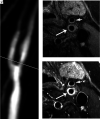Characterization of Restenosis following Carotid Endarterectomy Using Contrast-Enhanced Vessel Wall MR Imaging
- PMID: 35177544
- PMCID: PMC8910800
- DOI: 10.3174/ajnr.A7423
Characterization of Restenosis following Carotid Endarterectomy Using Contrast-Enhanced Vessel Wall MR Imaging
Abstract
Background and purpose: Restenosis is an important determinant of the long-term efficacy of carotid endarterectomy. Our aim was to assess the role of high-resolution vessel wall MR imaging for characterizing restenosis after carotid endarterectomy.
Materials and methods: Patients who underwent vessel wall MR imaging after carotid endarterectomy were included in this study. Restenotic lesions were classified as myointimal hyperplasia or recurrent atherosclerotic plaques based on MR imaging features of lesion compositions. Imaging characteristics of myointimal hyperplasia were compared with those of normal post-carotid endarterectomy and recurrent plaque groups. Recurrent plaques were matched with primary plaques by categories of stenosis, and differences in plaque features were compared between the 2 groups.
Results: Twenty-two recurrent lesions from 18 patients (14 unilateral and 4 bilateral) were classified as myointimal hyperplasia or recurrent plaque. Myointimal hyperplasia showed no difference in enhancement compared with normal post-carotid endarterectomy vessels (5 unilateral) but showed stronger enhancement than recurrent plaques (80.10% [SD, 42.42%] versus 56.74% [SD, 46.54%], P = .042). A multivariate logistic regression model of plaque-feature detection in recurrent plaques compared with primary plaques adjusted for maximum wall thickness revealed that recurrent plaques were longer (OR, 4.27; 95% CI, 1.32-13.85; P = .015) and more likely to involve a flow divider and side walls (OR, 6.96; 95% CI, 1.37-35.28; P = .019). Recurrent plaques had a higher prevalence of intraplaque hemorrhage (61.5% versus 30.8%, P = .048) by a χ2 test, but compositional differences were not significant in the multivariate model.
Conclusions: Vessel wall MR imaging can distinguish recurrent plaques from myointimal hyperplasia and reveal features that may differ between primary and recurrent plaques, highlighting its value for evaluating patients with carotid restenosis.
© 2022 by American Journal of Neuroradiology.
Figures




Similar articles
-
Non-invasive imaging of carotid arterial restenosis using 3T cardiovascular magnetic resonance.J Cardiovasc Magn Reson. 2014 Jan 8;16(1):5. doi: 10.1186/1532-429X-16-5. J Cardiovasc Magn Reson. 2014. PMID: 24400841 Free PMC article.
-
Analysis of Recurrent Stenosis After Carotid Endarterectomy Featuring Primary Plaque Calcification.Neurosurgery. 2017 Jun 1;80(6):863-870. doi: 10.1093/neuros/nyw119. Neurosurgery. 2017. PMID: 28368527
-
Utility of Complementary Magnetic Resonance Plaque Imaging and Contrast-Enhanced Ultrasound to Detect Carotid Vulnerable Plaques.J Am Heart Assoc. 2019 Apr 16;8(8):e011302. doi: 10.1161/JAHA.118.011302. J Am Heart Assoc. 2019. PMID: 30977413 Free PMC article.
-
A systemic review into carotid plaque features as predictors of restenosis after carotid endarterectomy.J Vasc Surg. 2021 Jun;73(6):2179-2188.e4. doi: 10.1016/j.jvs.2020.10.084. Epub 2020 Nov 27. J Vasc Surg. 2021. PMID: 33253876
-
Biology and treatment of recurrent carotid stenosis.J Cardiovasc Surg (Torino). 2012 Feb;53(1 Suppl 1):27-34. J Cardiovasc Surg (Torino). 2012. PMID: 22433721 Review.
References
-
- Bonati LH, Gregson J, Dobson J, et al. . Restenosis and risk of stroke after stenting or endarterectomy for symptomatic carotid stenosis in the International Carotid Stenting Study (ICSS): secondary analysis of a randomised trial. Lancet Neurol 2018;17:587–96 10.1016/S1474-4422(18)30195-9 - DOI - PMC - PubMed
MeSH terms
LinkOut - more resources
Full Text Sources
